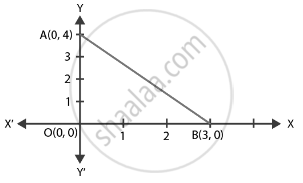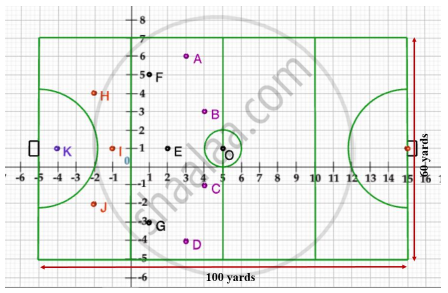Advertisements
Advertisements
प्रश्न
The perimeter of a triangle with vertices (0, 4), (0, 0) and (3, 0) is ______.
विकल्प
5 units
12 units
10 units
11 units
`7 + sqrt(5)` units
उत्तर
The perimeter of a triangle with vertices (0, 4), (0, 0) and (3, 0) is 12 units.
Explanation:
The vertices of a triangle are (0, 4), (0, 0) and (3, 0).
Now, perimeter of ΔAOB = Sum of the length of all its sides
= Distance between (OA + OB + AB)
Distance between the points (x1, y1) and (x2, y2) is given by,
d = `sqrt((x_2 - x_1)^2 + (y_2 - y_1)^2)`
To find:
Distance between A(0, 4) and O(0, 0) + Distance between O(0, 0) and B(3, 0) + Distance between A(0, 4) and B(3, 0)
= `sqrt((0 - 0)^2 + (0 - 4)^2) + sqrt((3 - 0)^2 + (0 - 0)^2) + sqrt((3 - 0)^2 + (0 - 4)^2)`
= `sqrt(0 + 16) + sqrt(9 + 0) + sqrt((3)^2 + (4)^2`
= `4 + 3 + sqrt(9 + 16)`
= `7 + sqrt(25)`
= 7 + 5
= 12
Therefore, the required perimeter of the triangle is 12.
संबंधित प्रश्न
If P (2, – 1), Q(3, 4), R(–2, 3) and S(–3, –2) be four points in a plane, show that PQRS is a rhombus but not a square. Find the area of the rhombus
Find the distance of a point P(x, y) from the origin.
A(–8, 0), B(0, 16) and C(0, 0) are the vertices of a triangle ABC. Point P lies on AB and Q lies on AC such that AP : PB = 3 : 5 and AQ : QC = 3 : 5. Show that : PQ = `3/8` BC.
Using the distance formula, show that the given points are collinear:
(-2, 5), (0,1) and (2, -3)
Find the distance between the following point :
(p+q,p-q) and (p-q, p-q)
Find the value of a if the distance between the points (5 , a) and (1 , 5) is 5 units .
Find the relation between a and b if the point P(a ,b) is equidistant from A (6,-1) and B (5 , 8).
Find the relation between x and y if the point M (x,y) is equidistant from R (0,9) and T (14 , 11).
P and Q are two points lying on the x - axis and the y-axis respectively . Find the coordinates of P and Q if the difference between the abscissa of P and the ordinates of Q is 1 and PQ is 5 units.
Case Study -2
A hockey field is the playing surface for the game of hockey. Historically, the game was played on natural turf (grass) but nowadays it is predominantly played on an artificial turf.
It is rectangular in shape - 100 yards by 60 yards. Goals consist of two upright posts placed equidistant from the centre of the backline, joined at the top by a horizontal crossbar. The inner edges of the posts must be 3.66 metres (4 yards) apart, and the lower edge of the crossbar must be 2.14 metres (7 feet) above the ground.
Each team plays with 11 players on the field during the game including the goalie. Positions you might play include -
- Forward: As shown by players A, B, C and D.
- Midfielders: As shown by players E, F and G.
- Fullbacks: As shown by players H, I and J.
- Goalie: As shown by player K.
Using the picture of a hockey field below, answer the questions that follow:

If a player P needs to be at equal distances from A and G, such that A, P and G are in straight line, then position of P will be given by ______.
